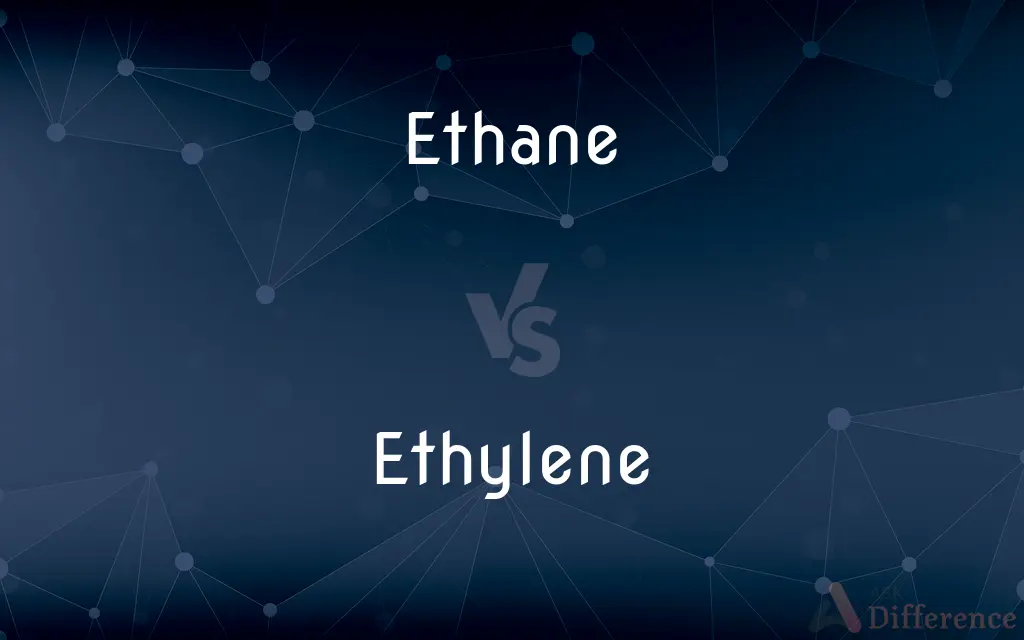Ethane vs. Ethylene — What's the Difference?
Edited by Tayyaba Rehman — By Urooj Arif — Updated on March 4, 2024
Ethane is a saturated hydrocarbon used primarily as a fuel and feedstock, while ethylene is an unsaturated hydrocarbon critical in the production of plastics and other chemicals.

Difference Between Ethane and Ethylene
Table of Contents
ADVERTISEMENT
Key Differences
Ethane (C2H6) is a colorless, odorless gas at room temperature, belonging to the alkane family, which means it has single bonds between carbon atoms, making it a saturated hydrocarbon. It's found in natural gas and petroleum and is used mainly as a fuel and a petrochemical feedstock. Ethylene (C2H4), on the other hand, is an unsaturated hydrocarbon with a double bond between its carbon atoms, classifying it as an alkene.
Ethane's stability and lack of double bonds make it less reactive than ethylene, limiting its use to fuel, refrigeration, and as a feedstock for ethylene production through cracking. This double bond makes ethylene highly reactive and a key building block in the petrochemical industry. It's used extensively in the production of polymers (such as polyethylene), antifreeze, and other important chemicals. Ethylene is also a plant hormone that regulates a wide range of processes, including fruit ripening and flower wilting.
While both gases are derived from petroleum and have similar molecular formulas, their chemical properties differ significantly due to the presence (ethylene) or absence (ethane) of a double bond. This difference in bonding leads to distinct uses in industry: ethane is primarily a feedstock for producing ethylene and other chemicals, while ethylene is a foundational chemical used directly in manufacturing a wide array of products.
Ethane's role in the energy sector as a natural gas component and a feedstock for ethylene production highlights its importance in both the energy and chemical industries. Ethylene's versatility and reactivity make it indispensable in creating polymers, solvents, and many other chemicals, underscoring its critical role in modern manufacturing and agriculture.
The production and use of ethane and ethylene reflect broader economic and environmental considerations, including energy efficiency, resource utilization, and the impact of chemical manufacturing on the environment. As the demand for plastics and other ethylene-derived products grows, so does the importance of ethane as a primary source for ethylene production, linking the fate of these two hydrocarbons in the global economy.
ADVERTISEMENT
Comparison Chart
Type of Hydrocarbon
Saturated (Alkane)
Unsaturated (Alkene)
Chemical Bonding
Single bonds between carbon atoms
Double bond between carbon atoms
Reactivity
Less reactive
Highly reactive
Uses
Fuel, refrigeration, ethylene production
Production of plastics, antifreeze, plant hormone
Source
Natural gas, petroleum
Petroleum, natural gas cracking
Industrial Role
Feedstock for ethylene production
Key building block in petrochemical industry
Compare with Definitions
Ethane
Feedstock for ethylene production.
Ethane cracking is a primary source of ethylene.
Ethylene
Used in making solvents and antifreeze.
Ethylene is a precursor to ethylene glycol.
Ethane
Less reactive alkane.
Ethane's single bonds make it less chemically active.
Ethylene
Produced through ethane cracking.
Cracking ethane yields ethylene for industrial use.
Ethane
A stable hydrocarbon used as fuel.
Ethane is combusted in industrial heaters.
Ethylene
Key petrochemical building block.
Ethylene is crucial for polyethylene production.
Ethane
Component of natural gas.
Ethane is separated from natural gas for various uses.
Ethylene
Plant hormone regulating growth.
Ethylene gas speeds up fruit ripening.
Ethane
Used in refrigeration.
Ethane serves as a refrigerant in low-temperature systems.
Ethylene
Highly reactive due to double bonds.
Ethylene's reactivity facilitates polymerization.
Ethane
Ethane ( or ) is an organic chemical compound with chemical formula C2H6. At standard temperature and pressure, ethane is a colorless, odorless gas.
Ethylene
(organic chemistry) The divalent radical derived from ethane.
Ethane
A colourless, odourless, flammable gas which is a constituent of petroleum and natural gas. It is the second member of the alkane series.
Ethylene
Ethylene (IUPAC name: ethene) is a hydrocarbon which has the formula C2H4 or H2C=CH2. It is a colorless flammable gas with a faint "sweet and musky" odor when pure.
Ethane
A colorless, odorless gaseous alkane, C2H6, that occurs as a constituent of natural gas and is used as a fuel and a refrigerant.
Ethylene
A colorless flammable gas, C2H4, derived from natural gas and petroleum and also occurring as a natural plant hormone, used as a source of many organic compounds, in welding and cutting metals, to ripen citrus fruits, and as an anesthetic. Also called ethene.
Ethane
An aliphatic hydrocarbon, C2H6, gaseous at normal temperatures and pressures, being a constituent of natural gas.
Ethylene
(organic compound) The common name for the organic chemical compound ethene. The simplest alkene, a colorless gaseous (at room temperature and pressure) hydrocarbon with the chemical formula C<sub>2</sub>H<sub>4</sub>.
Ethane
The same compound, subjected to modification by replacing one or more of the hydrogen atoms with other radicals.
Chlorinated ethanes; halogenated ethanes
Ethylene
A colorless, gaseous hydrocarbon, C2H4, forming an important ingredient of illuminating gas, and also obtained by the action of concentrated sulphuric acid in alcohol. It is an unsaturated compound and combines directly with chlorine and bromine to form oily liquids (Dutch liquid), - hence called olefiant gas. Called also ethene, elayl, and formerly, bicarbureted hydrogen.
Ethane
A gaseous hydrocarbon, C2H6, forming a constituent of ordinary illuminating gas. It is the second member of the paraffin series, and its most important derivatives are common alcohol (ethyl alcohol), acetaldehyde, ether, and acetic acid. Called also dimethyl.
Ethylene
A flammable colorless gaseous alkene; obtained from petroleum and natural gas and used in manufacturing many other chemicals; sometimes used as an anesthetic
Common Curiosities
How does ethylene function as a plant hormone?
Ethylene regulates plant processes like fruit ripening, flower opening, and leaf shedding by signaling changes in growth patterns.
Why is ethylene more reactive than ethane?
Ethylene's double bond makes it more chemically active, allowing it to participate in a variety of reactions, including polymerization.
Why is ethylene important in agriculture?
Ethylene's role as a plant hormone makes it essential in agricultural practices, such as controlling the timing of fruit ripening for market.
Can ethane be converted into ethylene?
Yes, ethane can be converted into ethylene through a process called cracking, which breaks the single bonds to form double bonds.
What future trends might affect ethane and ethylene usage?
Trends include the search for sustainable alternatives to petrochemicals, recycling advancements, and shifts in global energy sources.
What are the main uses of ethane?
Ethane is primarily used as a fuel, in refrigeration, and as a feedstock for producing ethylene and other chemicals.
How are ethane and ethylene produced?
Ethane is extracted from natural gas and petroleum, while ethylene is produced mainly through the cracking of ethane and other hydrocarbons.
What environmental considerations exist for ethane and ethylene?
The production and use of these chemicals contribute to emissions and require energy, impacting environmental sustainability and climate change.
What distinguishes ethane from ethylene?
Ethane is a saturated hydrocarbon with single carbon-carbon bonds, while ethylene is unsaturated with a carbon-carbon double bond, leading to different reactivities and uses.
Which is more important industrially, ethane or ethylene?
Both are crucial; ethane is a key feedstock for ethylene production, while ethylene is fundamental in manufacturing plastics and other chemicals.
What are the challenges in ethane and ethylene production?
Challenges include managing emissions, ensuring energy efficiency, and adapting to fluctuating market demands for petrochemical products.
How do ethane and ethylene contribute to the petrochemical industry?
They are essential components, with ethane serving as a feedstock for ethylene, which in turn is a building block for a wide range of chemicals and materials.
How has the demand for ethylene influenced ethane markets?
Growing demand for ethylene, especially for plastic production, has increased the value and extraction of ethane as a primary feedstock.
Can ethylene production from ethane be made more sustainable?
Technological advances and process improvements aim to make ethylene production more efficient and less environmentally impactful.
How are innovations in cracking technology impacting ethylene production?
Innovations aim to make cracking more efficient, reducing energy consumption and emissions, and increasing yield and purity of ethylene.
Share Your Discovery

Previous Comparison
Memorial vs. Memoriam
Next Comparison
Brook vs. StreamAuthor Spotlight
Written by
Urooj ArifUrooj is a skilled content writer at Ask Difference, known for her exceptional ability to simplify complex topics into engaging and informative content. With a passion for research and a flair for clear, concise writing, she consistently delivers articles that resonate with our diverse audience.
Edited by
Tayyaba RehmanTayyaba Rehman is a distinguished writer, currently serving as a primary contributor to askdifference.com. As a researcher in semantics and etymology, Tayyaba's passion for the complexity of languages and their distinctions has found a perfect home on the platform. Tayyaba delves into the intricacies of language, distinguishing between commonly confused words and phrases, thereby providing clarity for readers worldwide.
















































